Introduction
As a part of efforts to assess the potential impacts upon Eureka County of construction and operation of a Nuclear Waste Repository at Yucca Mountain, Eureka County wishes to develop and maintain an accurate picture of existing socioeconomic conditions and trends in the county. Two previous Socioeconomic Conditions and Trends Reports have been completed: one in 1994 and one in 2003.
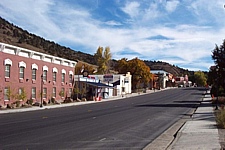 This is an update to the 2003 report. All three reports are divided into five sections: Population and Housing, The Economy; Local Government Fiscal Conditions, Education, and Social Indicators. Together, the three documents present a wide range of information that shows socioeconomic conditions and trends in Eureka County for a period exceeding twenty years. The five sections of the report are summarized below, with more detailed information offered in the body of the report.
This is an update to the 2003 report. All three reports are divided into five sections: Population and Housing, The Economy; Local Government Fiscal Conditions, Education, and Social Indicators. Together, the three documents present a wide range of information that shows socioeconomic conditions and trends in Eureka County for a period exceeding twenty years. The five sections of the report are summarized below, with more detailed information offered in the body of the report.
Located in northeastern Nevada, Eureka County was established in 1873. The county covers 4,182 square miles.
Geography is typical basin and range topography, with long, mostly north-south trending, alluvium-filled valleys separated by mountain ranges. Elevations range from a high of around 10,461 feet at the Summit Mountains in the Monitor Range to about 4,000 feet elevation on the floors of several of the lower basins. Principal communities are the county seat, Eureka, in the southern end of the county and the towns of Crescent Valley and Beowawe in the north. The Humboldt River winds through the northern part of the county. This is a major transportation corridor both historically and in the present. Thousands traveled the emigrant trail along the Humboldt River in the nineteenth century; now the corridor holds Interstate Highway 80, as well as Union Pacific railroad tracks. U.S. Highway 50 provides access to the southern end of the county and to the county seat.
POPULATION AND HOUSING
Eureka County population was estimated to be 1,485 persons in 2005. This is an increase of 65 persons, or 4.5 percent, since 2003. The County's average annual population growth over the years 1993-2005 has been -0.2 percent, a negative growth rate overall. Population fell sharply in 1994, increased to a high of an estimated 1,895 persons in 1998, declined again reaching a low of 1,384 persons in 2003, then rose to an estimated 1,485 persons in 2005.
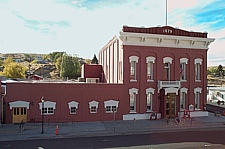 As a comparison, the average annual population growth rate of the state of Nevada over the period 1993-2005 was 4.86%. In Eureka County the greatest part of population change is due to in or out-migration.
As a comparison, the average annual population growth rate of the state of Nevada over the period 1993-2005 was 4.86%. In Eureka County the greatest part of population change is due to in or out-migration.
Eureka County has an extremely low population density - only 0.34 persons per square mile, as compared to 22 persons per square mile for Nevada as a whole, and 83.8 persons per square mile nationwide. 51% of the estimated 2005 county population of 1,485 resided in the town of Eureka or Crescent Valley. Overall housing units in Eureka County increased from 801 units in 1993 to 888 in 2006. Mobile homes remained the dominant housing type, accounting for 69% of county housing in 2006.
THE ECONOMY
Gold mining continues as the principal economic engine of Eureka County. Over the period 1993 - 2004 there were four producing gold mines in the county operating at different times. In 2002 Eureka County produced 37% of all gold produced in Nevada, and in 2004 the county produced 36% of all Nevada gold. Two mine complexes in northern Eureka County continue to be some of the most productive mines in Nevada and indeed in the entire country, with Newmont Mining Corporation's Carlin Trend mines producing over 1.13 million ounces of gold in 2004, and Barrick Gold Corporation's Betze-Post Mine producing over 1.4 million ounces in that year.
During the late 1990's, lower gold prices caused many Nevada mines to scale back exploration and to scale back or temporarily close some operations. Since then the price of gold has again risen to over $300 per ounce in 2002 and over $600 per ounce in 2006. As a result of these higher gold prices, several Nevada gold mining operations are expanding both operations and exploration. Newmont Mining Corporation's Leeville underground mine near the existing Deep Post Mine in northern Eureka County began production in the second
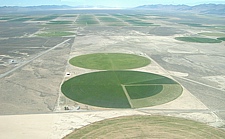 half of 2005 and is scheduled to reach design production level in 2007. At full production rates, Leeville is expected to produce up to 550,000 ounces of gold per year, with a current mine life in excess of eight years. Newmont is also expanding the Gold Quarry Mine with a project called Gold Quarry South Layback. The current plan for this site includes a minimum six-year mine life. Overall, Newmont reports 33.3 million ounces of reserves in the company's Nevada Operations.
Barrick Gold Corporation describes the Goldstrike Property in northern Eureka County as its "flagship property,"' reporting gold reserves at year-end 2005 of over 17 million ounces. The mine is the company's largest producer. Barrick is conducting further exploration in the vicinity of the existing mine. Barrick is also developing the East Archimedes Mine at the old Ruby Hill Mine site near Eureka. The East Archimedes Mine is expected to enter production in mid-2007 and Barrick reports reserves of 1.0 million ounces at December 31, 2005.
half of 2005 and is scheduled to reach design production level in 2007. At full production rates, Leeville is expected to produce up to 550,000 ounces of gold per year, with a current mine life in excess of eight years. Newmont is also expanding the Gold Quarry Mine with a project called Gold Quarry South Layback. The current plan for this site includes a minimum six-year mine life. Overall, Newmont reports 33.3 million ounces of reserves in the company's Nevada Operations.
Barrick Gold Corporation describes the Goldstrike Property in northern Eureka County as its "flagship property,"' reporting gold reserves at year-end 2005 of over 17 million ounces. The mine is the company's largest producer. Barrick is conducting further exploration in the vicinity of the existing mine. Barrick is also developing the East Archimedes Mine at the old Ruby Hill Mine site near Eureka. The East Archimedes Mine is expected to enter production in mid-2007 and Barrick reports reserves of 1.0 million ounces at December 31, 2005.
Overall, it appears that with high and rising gold prices, gold production and exploration in Eureka County will continue to be important over the next ten or more years. Producers report increased costs, however, mostly due to energy costs. To address these rising costs, Newmont's Nevada operations propose to build a 203- megawatt coal-fired power plant near the Carlin Trend. The company plans to sell excess capacity from the plant to Sierra Pacific Power.
In other mineral activities in the county, Eureka County's Blackburn Field was Nevada's second highest volume producer for the third year in a row in 2004, averaging 68 barrels of oil and 1,173 barrels of water per day. According to the Nevada Bureau of Mines, discovery of oil in the "Wolverine" area of western Utah coupled with the high price of oil has sparked renewed interest in oil exploration in eastern Nevada and western Utah. One of the larger projects is Eden Energy Corporation's Noah Project. In 2004, Eden Energy of Vancouver, British Columbia, acquired a Participation Agreement with Nevada-based Cedar Strat and also acquired about 211,000 acres in leases covering the Diamond Mountains along the border between Eureka and White Pine Counties.
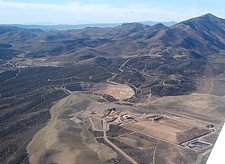 Agriculture is not the county's biggest source of employment, but it remains important. Principal agricultural commodities produced in Eureka County are cattle and hay. There were 73 farms or ranches in the county in 2002, producing about $12.7 million in agricultural products This is a drop in the number of farms/ranches from 85 in 1987. The average per farm/ranch market value of agricultural products sold in 2002 was $173,412.
Agriculture is not the county's biggest source of employment, but it remains important. Principal agricultural commodities produced in Eureka County are cattle and hay. There were 73 farms or ranches in the county in 2002, producing about $12.7 million in agricultural products This is a drop in the number of farms/ranches from 85 in 1987. The average per farm/ranch market value of agricultural products sold in 2002 was $173,412.
Mining jobs continue to surpass all other Eureka County jobs combined, with 3,466 of the total 3,806 jobs in the county reported by the Nevada Department of Employment Training and Rehabilitation in 2005. Mining employment dropped slightly in 2003 and 2004, but rose again in 2005. Government is the second-largest employment category in the county, with 178 jobs reported in 2005.
The unemployment rate in Eureka County peaked at 10.7 % in 1994, well above state and national unemployment rates. In subsequent years the unemployment rate fell to a low of 2.5% in 2000, then rose again to 4.9 percent in 2006, making Eureka County's 2006 unemployment rate lower than the national rate but higher than the Nevada rate.
Eureka County has more jobs than workers The two largest mines in the county are in the far northern end of the county, closer to the towns of Elko and Carlin than to Eureka County's population centers of Crescent Valley and Eureka, so most workers commute to the mines from these Elko County towns. Some Crescent Valley residents, however, work at the Cortez Complex Mine, which is within Lander County. The mining sector appears to affect not only the unemployment rate in the county, but also the size of the labor force itself. Subsequent to 1998, when mining employment began to decline, the overall size of the labor force declined, from the 1998 high of 950 to 760 in 2002.
Various income measurement for Eureka County show a mixed picture. Eureka County per capita income was higher than that of the state overall through 1996, then subsequently fell below. Eureka County per capita income continues to rise, however, increasing by almost 6% between 2003 and 2004. U.S. Census 2000 data show that median household income in Eureka was lower than in Nevada as a whole, but very close to that of the nation as a whole. Median family income in Eureka County was closer to the Nevada median than household income. The earnings of male, full-time, year-round workers were significantly higher in Eureka County than in Nevada as a whole, reflecting the relatively high wages in the mining industry, while female, full-time workers earned less than in Nevada as a whole.
Total taxable sales in Eureka County declined by 18.8% over the ten-year period between fiscal year 1995-96 and fiscal year 2004-05. The lowest point in this decline was reached in FY 2001-2002. Since then taxable sales have increased in many sectors, led by mining, which remains by far the county's largest generator of taxable sales. In 2004-2005, metal mining made up 49.6% of the county's taxable sales. Other top sectors in the county include wholesale trade/durable goods, industrial and commercial machinery, chemical products, and business services.
In the tourism sector, visitation to the Eureka Sentinel Museum has increased over the two decades since its opening, but not steadily. Visitation to the museum reached a high of 5,083 visitors in 1995, then declined in subsequent years. Room tax collections climbed until 2002, but dropped by 15% between 2002 and 2003. Between 2003 and 2004 room tax collections rose again by 19%, then dropped slightly between 2004 and 2005. Gaming license collections have remained steady, albeit with a large jump in collections in 2001. Eureka County continues to pursue diversified economic development including tourism.
LOCAL GOVERNMENT FISCAL CONDITIONS
The Eureka County government provides a full range of services including police and volunteer fire protection; the construction and maintenance of sanitation, water and sewer facilities; recreational facilities including parks, swimming pool, museum, opera house, and fair and rodeo grounds; judicial services; economic development; medical facilities; road construction and maintenance; television services; Diamond Valley weed and rodent control; and senior citizen facilities. The unincorporated towns of Eureka and Crescent Valley are blended component units of the County government.
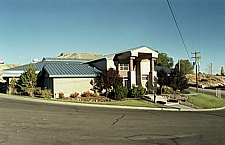
In 2005, principal officials of Eureka County consisted of a three-member Board of County Commissioners, an Auditor/Recorder, Clerk/Treasurer, Assessor, District Attorney, Sheriff, two Justices of the Peace, one in Beowawe Township (offices located in Crescent Valley) and one in Eureka, a Public Works Director, a Facilities Manager, two Senior Center Coordinators, and an EMS Coordinator. In 2005 Eureka County had 125 government employees.
Ad valorem taxes and intergovernmental revenues continue to be the two main sources of Eureka County revenues, with ad valorem taxes accounting for 35% and intergovernmental revenues accounting for 50% of total 2005 revenues. In fiscal year 2005 Eureka County collected more revenue than it expended.

Eureka County has several fiscal policies in place designed to cushion the impacts of slowdowns or changes in the major industry. The County has a policy of retaining large ending balances and building up reserve funds. There are two reserve funds, a Future Reserve Fund and a Building Operation and Maintenance Reserve Fund. On June 30, 2005, the balance in the Future Reserve Fund was $7,502,193, and the balance in the Building Operation and Maintenance Reserve Fund was $6,381,382.
In 2005 the county expended a total of $11,223,057, an increase in spending of 25% from 1999. The General Government and Public Safety functions within the County's General Fund, together with the Road Fund, are the largest County expenditure categories. General Fund expenditures make up 69.4% of County expenditures. The County spent $71,763 and $125,122 from the Building Operation and Maintenance Reserve Fund in FY 2004 and 2005. No money was spent from the Future Reserve Fund in those years.
EDUCATION
The Eureka County School District is one of the smallest districts in the state. The district operates the Eureka Elementary School and the Eureka County Junior-Senior High School in Eureka, the former with a capacity of 240 students and the latter with a capacity of 240 students; and the Crescent Valley Elementary School in Crescent Valley, with a capacity of 180 students. High school students from Crescent Valley and Beowawe attend Battle Mountain High School. Pine Valley high school students go to Carlin High School. There are no private schools in Eureka County.
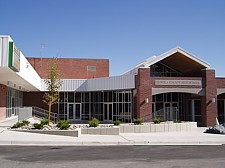
In 2005 there were 224 students enrolled in Eureka County schools, and 41 home schooled students. The highest school enrollment during the period 1994 to 2005 was in 1998 with 378 students enrolled, and the lowest enrollment year during the period was 2003, with 220 students enrolled.
Both revenues and expenditures dropped over the 1995-2004 period. During the years 2000 to 2004 expenditures were higher than revenues. In 2005, however, revenues increased sharply while expenditures continued to drop, making school district revenues higher than expenditures for the first time in four years. Spending for regular, vocational and other instructional programs was approximately 48% of overall school district expenditures. Undistributed expenditures, which include spending for administration, operation and maintenance of facilities, student transportation, and facilities acquisition, also made up 48% of school expenditures.
Local sources make up 97% of school district revenue. The largest category is ad valorem taxes, which makes up 83% of total local support, followed by school support taxes and a motor vehicle privilege tax. In 2004 Eureka County voters passed a $6 million school bond to fund expansion and retrofitting of the Eureka County High School.
SOCIAL INDICATORS
Eureka County towns are relatively isolated, but county and town governments, as well as private businesses, provide a range of services to residents and visitors including two branch libraries, an opera house, a swimming pool, rodeo ground and parks, and two senior citizens centers. Nevada Health Centers, Inc. operates two clinics in Eureka County, one in the town of Eureka and one in Crescent Valley. For acute care, Eureka County residents visit hospitals in nearby counties.
Voter turnout in Eureka County is very high. Voter turnout in the last four general elections averaged 86.7%, while in Nevada as a whole the percentage of registered voters who voted averaged only 64%. In 2005 Eureka County's crime rate was just over one quarter of the crime rate for the state as a whole. Traffic crashes in Eureka County in 2002 totaled 115, with four fatal crashes. Eureka County has the fifth lowest crash rate of all Nevada counties.
|

